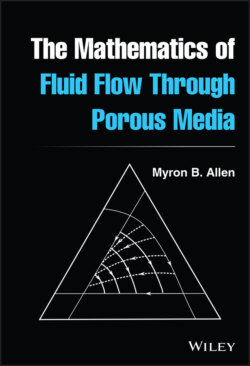The Mathematics of Fluid Flow Through Porous Media

Реклама. ООО «ЛитРес», ИНН: 7719571260.
Оглавление
Myron B. Allen III. The Mathematics of Fluid Flow Through Porous Media
The Mathematics of Fluid Flow Through Porous Media
Table of Contents
List of Tables
List of Illustrations
Guide
Pages
Preface
1 Introduction. 1.1 Historical Setting
1.2 Partial Differential Equations (PDEs)
1.3 Dimensions and Units
1.4 Limitations in Scope
2 Mechanics
2.1 Kinematics of Simple Continua
2.1.1 Referential and Spatial Coordinates
2.1.2 Velocity and the Material Derivative
2.2 Balance Laws for Simple Continua
2.2.1 Mass Balance
2.2.2 Momentum Balance
2.3 Constitutive Relationships
2.3.1 Body Force
2.3.2 Stress in Fluids
2.3.3 The Navier–Stokes Equation
2.4 Two Classic Problems in Fluid Mechanics
2.4.1 Hagen–Poiseuille Flow
2.4.2 The Stokes Problem
2.5 Multiconstituent Continua
2.5.1 Constituents
2.5.2 Densities and Volume Fractions
2.5.3 Multiconstituent Mass Balance
2.5.4 Multiconstituent Momentum Balance
3 Single‐fluid Flow Equations
3.1 Darcy's Law
3.1.1 Fluid Momentum Balance
3.1.2 Constitutive Laws for the Fluid
3.1.3 Filtration Velocity
3.1.4 Permeability
3.2 Non‐Darcy Flows
3.2.1 The Brinkman Law
3.2.2 The Forchheimer Equation
3.2.3 The Klinkenberg Effect
3.3 The Single‐fluid Flow Equation
3.3.1 Fluid Compressibility and Storage
3.3.2 Combining Darcy's Law and the Mass Balance
3.4 Potential Form of the Flow Equation
3.4.1 Conditions for the Existence of a Potential
3.4.2 Calculating the Scalar Potential
3.4.3 Piezometric Head
3.4.4 Head‐Based Flow Equation
3.4.5 Auxiliary Conditions for the Flow Equation
3.5 Areal Flow Equation
3.5.1 Vertically Averaged Mass Balance
3.5.2 Vertically Averaged Darcy's Law
3.6 Variational Forms for Steady Flow
3.6.1 Standard Variational Form
3.6.2 Mixed Variational Form
3.7 Flow in Anisotropic Porous Media. 3.7.1 The Permeability Tensor
3.7.2 Matrix Representations of the Permeability Tensor
3.7.3 Isotropy and Homogeneity
3.7.4 Properties of the Permeability Tensor
3.7.5 Is Permeability Symmetric?
4 Single‐fluid Flow Problems
4.1 Steady Areal Flows with Wells
4.1.1 The Dupuit–Thiem Model
4.1.2 Dirac Models
4.1.3 Areal Flow in an Infinite Aquifer with One Well
4.2 The Theis Model for Transient Flows. 4.2.1 Model Formulation
4.2.2 Dimensional Analysis of the Theis Model
4.2.3 The Theis Drawdown Solution
4.2.4 Solving the Theis Model via Similarity Methods
4.3 Boussinesq and Porous Medium Equations
4.3.1 Derivation of the Boussinesq Equation
4.3.2 The Porous Medium Equation
4.3.3 A Model Problem with a Self‐similar Solution
5 Solute Transport
5.1 The Transport Equation
5.1.1 Mass Balance of Miscible Species
5.1.2 Hydrodynamic Dispersion
5.2 One‐Dimensional Advection
5.2.1 Pure Advection and the Method of Characteristics
5.2.2 Auxiliary Conditions for First‐Order PDEs
5.2.3 Weak Solutions
5.3 The Advection–Diffusion Equation
5.3.1 The Moving Plume Problem
5.3.2 The Moving Front Problem
5.4 Transport with Adsorption
5.4.1 Mass Balance for Adsorbate
5.4.2 Linear Isotherms and Retardation
5.4.3 Concave‐down Isotherms and Front Sharpening
5.4.4 The Rankine–Hugoniot Condition
6 Multifluid Flows
6.1 Capillarity. 6.1.1 Physics of Curved Interfaces
6.1.2 Wettability
6.1.3 Capillarity at the Macroscale
6.2 Variably Saturated Flow
6.2.1 Pressure Head and Moisture Content
6.2.2 The Richards Equation
6.2.3 Alternative Forms of the Richards Equation
6.2.4 Wetting Fronts
6.3 Two‐fluid Flows. 6.3.1 The Muskat–Meres Model
6.3.2 Two‐fluid Flow Equations
6.3.3 Classification of Simplified Flow Equations
6.4 The Buckley–Leverett Problem. 6.4.1 The Saturation Equation
6.4.2 Welge Tangent Construction
6.4.3 Conservation Form
6.4.4 Analysis of Oil Recovery
6.5 Viscous Fingering
6.5.1 The Displacement Front and Its Perturbation
6.5.2 Dynamics of the Displacement Front
6.5.3 Stability of the Displacement Front
6.6 Three‐fluid Flows
6.6.1 Flow Equations
6.6.2 Rock‐fluid Properties
6.7 Three‐fluid Fractional Flow Analysis
6.7.1 A Simplified Three‐fluid System
6.7.2 Classification of the Three‐fluid System
6.7.3 Saturation Velocities and Saturation Paths
6.7.4 An Example of Three‐fluid Displacement
7 Flows With Mass Exchange
7.1 General Compositional Equations. 7.1.1 Constituents, Species, and Phases
7.1.2 Mass Balance Equations
7.1.3 Species Flow Equations
7.2 Black‐oil Models
7.2.1 Reservoir and Stock‐tank Conditions
7.2.2 The Black‐oil Equations
7.3 Compositional Flows in Porous Media
7.3.1 A Simplified Compositional Formulation
7.3.2 Conversion to Molar Variables
7.4 Fluid‐phase Thermodynamics
7.4.1 Flash Calculations
7.4.2 Equation‐of‐state Methods
Appendix A Dedicated Symbols
Appendix B Useful Curvilinear Coordinates
B.1 Polar Coordinates
B.2 Cylindrical Coordinates
B.3 Spherical Coordinates
Appendix C The Buckingham Pi Theorem
C.1 Physical Dimensions and Units
C.2 The Buckingham Theorem
Appendix D Surface Integrals
D.1 Definition of a Surface Integral
D.2 The Stokes Theorem
D.3 A Corollary to the Stokes Theorem
Bibliography
Index. a
b
c
d
e
f
g
h
i
j
k
l
m
n
o
P
r
s
t
u
v
w
y
z
WILEY END USER LICENSE AGREEMENT
Отрывок из книги
Myron B. Allen
University of Wyoming
.....
The dimensionless parameter in Eq. (2.16) is the Reynolds number, named after Irish‐born fluid mechanician Osborne Reynolds [128]. This number serves as a unit‐free gauge of the ratio of inertial effects to viscous effects and, heuristically, as an index of mathematical intractability. We associate the regime with slow flows in which viscous effects dominate those associated with inertia. When is much smaller than 1, it is common to neglect the inertial terms.
.....